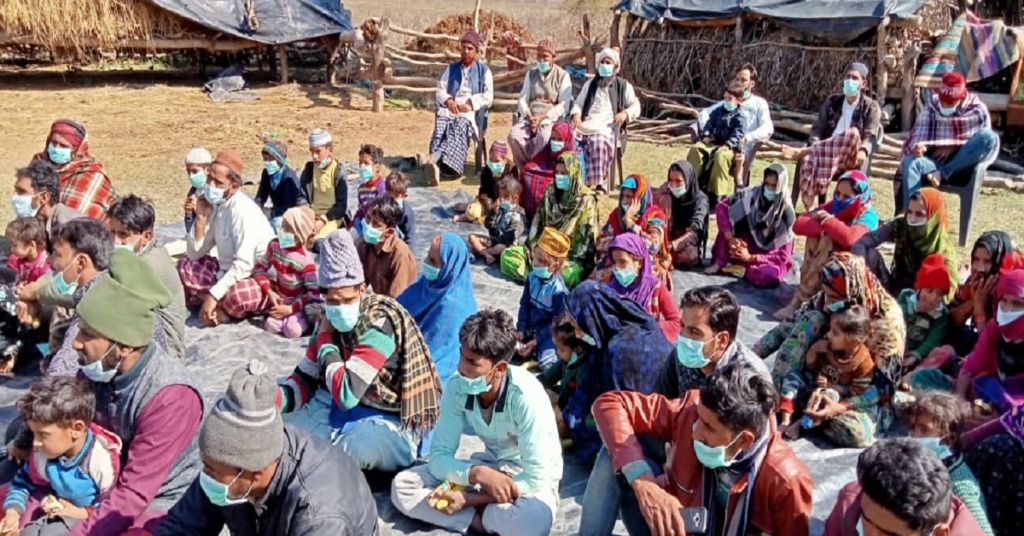The Van Gujjars of Shivalik forests have a curious dilemma. Should they stay put in the middle of a region that is used by the Army for firing practice, or pack up and leave… and then go where? Should they revert to the nomadic life of their ancestors, or start life afresh on rented land? Bureaucratic lethargy on resolving the issue is creating new hurdles as well.
The Shivalik Forest Division starts at the north of district Saharanpur of Uttar Pradesh, it shares the border with famed the Rajaji Tiger reserve of district Dehradun in Uttarakhand. There are three ranges at the Shivalik Forest Division: Badshahi Bagh Badkala Range, Shakumbari range, and the Mahord range.
Since the late 1920s the Shivalik Forest Division area has also been a home for the nomadic Van Gujjar community. The community elders recall families arriving here every winter, along with their cattle herds. As soon as summer arrived, the Gujjars of the Shivalik would once again pack up as their ancestors had done for eons, and then move towards the meadows of Himachal Pradesh and Uttarakhand. Over the years, many began staying on longer in one place, and according to the community, now the Shivalik Forest division is home to around 4,000 Van Gujjar families.
CJP’s Grassroots Fellowship Program aims at empowering young men and women, from the communities we work closely with, including migrant workers, Dalits, Adivasis, forest workers among other disadvantaged people, to report on issues closest to their hearts and home. Please Donate Now to empower our grassroots fellows.
However, life is certainly not ‘settled’ for those who have settled here over the decades. According to the community, the Shivalik Forest Division is under the administration of the Indian Army, and that has impacted their lives immensely. The army personnel engage in practicing their gun shooting skills here at the Shivalik Forest Division area. It was in the 1980s that the land was given by the forest division to the Indian Army. The army was reportedly told that this area was not inhabited by anyone. So the forces took over and set up their shooting range, and personnel began honing their firing skills with weapons of varying intensity.
The community elders recalled that in the beginning when the firing practices by the army were on, they had to leave the established grazing areas alone. Soon there was a gradual increase of the practice area used by the Indian army. The Van Gujjars that were residing there started facing a lot of problems. Some recall that a number of buffaloes died after they were hit by the stray bullets fired during practice by the forces. An elder alleged that even a woman from the settlement was hit a few years back and later succumbed to the injury.
The Van Gujjars say they are living in fear that they, a forest dwelling community will slowly be pushed out and away from the jungles of the forest department. However, some Van Gujjar community leaders and the Tribal Youth Organisation raised their voice to seek justice for the Van Gujjar families who were helpless, and feared they would be forced to leave Shivalik and live on rented land.
The Van Gujjar families say they have been denied their rights for generations, and do not want to leave Shivalik Hills which is now their home. However, each day brings new challenges as the maze of bureaucratic red tape seems to be adamant to deny them their traditional identity and rights.
This report is part of CJP Grassroots Fellow program and has been written by Mohammed Meer Hamza who is documenting the lives and challenges faced by the Van Gujjar community. Here he travels to meet Van Gujjar, families living in the Shivalik forest area which shares a border with Rajaji Tiger reserve.
Meet CJP Grassroot Fellow Mohammed Meer Hamza
Mohammed Meer Hamza (26) was born in a jungle. Literally! He hails from Uttarakhand and was born on the outskirts of the Rajaji National Park. Hamza is now pursuing a masters degree in social work. For over three years now, Hamza has been working actively as a social worker for the Van Gujjar community, helping them access education, retain their culture and know their rights. He has created a youth group and is educating them about the rights of forest dwelling communities, citizenship laws, conservation and security issues. He is also researching traditional forest produce and how to enable his community to market it effectively while retaining the balance of nature. Hamza has begun his research and documentation work. He writes to share his life, and work as a Van Gujjar youth leader.
Related:
Our life is linked to the forests we call home: Van Gujjars
Who sprayed chemicals in an eco-sensitive forest area in Haldwani?

